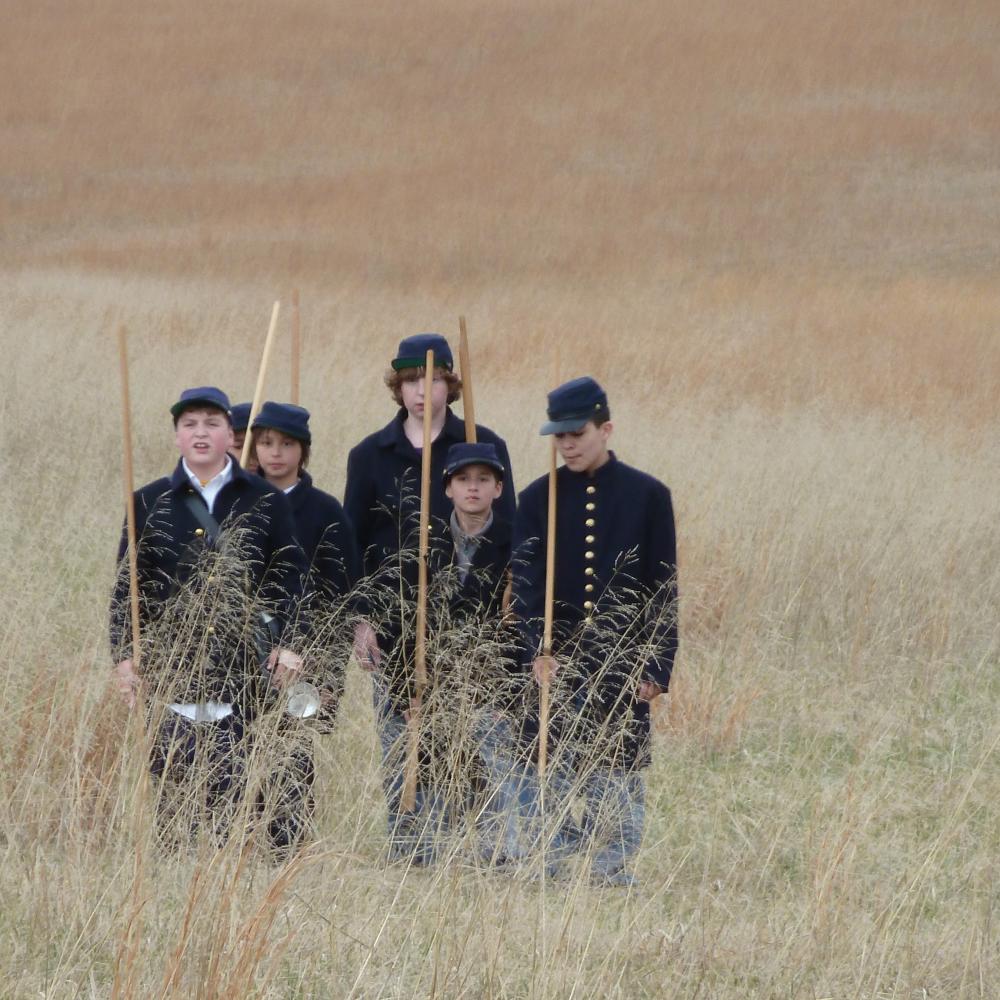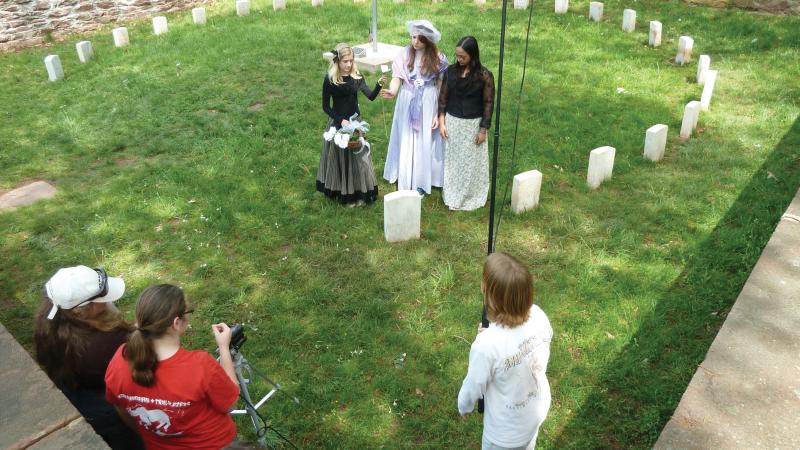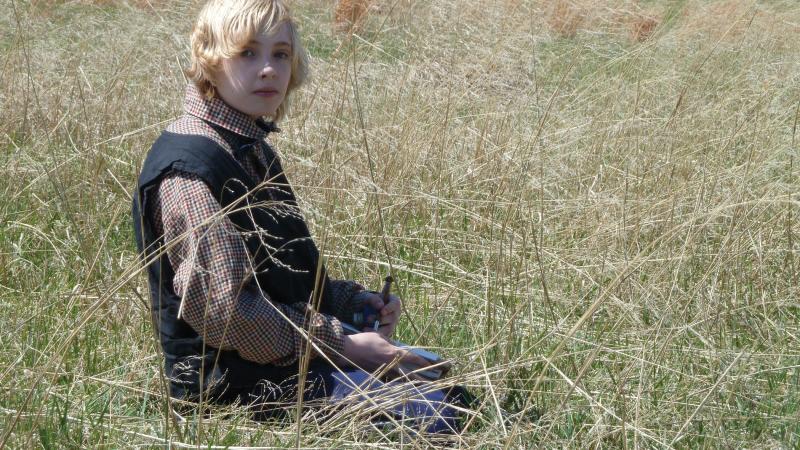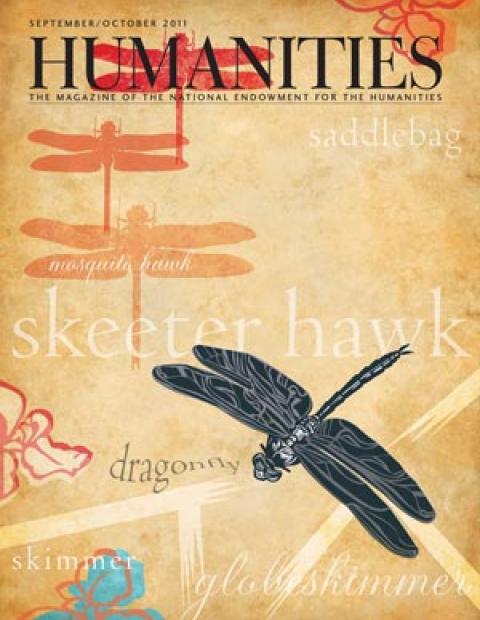To get to the Civil War battlefield of Ball's Bluff, you meander through a residential subdivision called Potomac Crossing on the outskirts of Leesburg, Virginia, past streets called Shanks Evans Road and Stone Court, named after the Confederate and Union officers who fought there. The entrance to the park is discreetly located in the farthest cul-de-sac of Ball’s Bluff Road. Civil War enthusiasts travel this route to see the terrain where 223 Union soldiers were killed in October 1861. Sadly, the park doesn’t draw many students from the local schools, but perhaps that is about to change. One hundred thirty-three rising eighth graders now have reason to feel a bond with their local battlefield. They recently examined Ball’s Bluff not only as an important site in their nation’s history but also as a link to their own past, using artifacts belonging to local families to help illuminate the complex history of their hometown.
Beginning in the winter of 2011, the entire seventh-grade communications class at nearby Smart’s Mill Middle School set out to research, script, act, direct, produce, and edit its own videos about the Civil War. Students pored over diaries, soldiers’ letters, newspaper accounts, and other primary sources to discover what life was like in Leesburg, on the home front and on the battlefield. For one seventh grader, the project turned personal when she and her mother recovered in their attic the war diary of their distant ancestor, Private Milton Smith.
Milton’s words caught the imagination of the students as they read his entries out loud together. “The students were riveted,” says teacher Kimberly Wright. Not only was the story dramatic, it seemed tangible and real. Between readings, students paused and looked up. And right there in the classroom, one hundred fifty years later, was a person related to this soldier. The diary, which contained letters to and from his family, had about forty entries beginning in the summer of 1861 and continuing through Christmas. It included Milton’s experience at Ball’s Bluff as a member of a Confederate regiment from Mississippi.
Milton’s diary talked about ordinary things in a soldier’s life—the price of goods, the scarcity of supplies, even raiding clothes and belongings off the Union dead after a victory. But the class focused on what Wright describes as an “unrequited need to know that his family is still there.” Milton wrote home every day, and, “every letter ends, ‘keep writing, keep writing.’” To his mother he wrote, “I am in hopes that the time will soon come that we will meet around the dinner table and talk about older times. And if not there, then the sweet home above. You must remember when kneeling by the bedside to say a few words for me. I know I am a hard sinner but not afraid to die. . . . I am tough as a knot. Your affectionate son till death, Milton.”
These words were used in the final six-minute video produced by Wright’s class, Soldier Milton Smith, which went through a vigorous, cooperative editing process. Although not every student was a script writer—others volunteered to be editors, actors, the director, music editors, prop managers, etc.—every student had a say about the final words. “We did group editing,” explains Wright. “The whole class would read the script and make suggestions. There was a lot of give and take. It took a lot of courage to be representing your entire class and then have to listen to them as they critique it. The students really led the show.”
Project Reverses Downward Trend
The film project at Smart’s Mill is one of thirteen being sponsored by the Journey Through Hallowed Ground Partnership (JTHG), which joins the resources of national battlefields with students and teachers from local middle schools. When JTHG first approached the Harpers Ferry National Historical Park in 2009 for a pilot program, the Chief of Interpretation, Dennis Frye, spoke frankly about what they needed. “He said, ‘We notice that numbers are trending downward of kids coming to the park. We’re not giving information to the students in a way that they want to receive it,’” remembers Beth Erickson, vice president of JTHG.
When students at Harpers Ferry Middle School were asked who had ever visited the site (the school is actually located within the boundaries of the park), not one sixth grader raised a hand. Now, those same students have mentored a new class of sixth graders on their film projects, and two have become interns at the park.
Members of JTHG staff help propel the projects from the outset, organizing immersion days at the battlefields, providing guest presenters, bringing primary source materials from archives, and training the students on the finer points of filmmaking—including how to use Final Cut Express, an editing tool used by professional filmmakers. But the students take charge from there, choosing their topics and researching their stories and deciding how to film a scene.
So far, twelve videos have been produced with support of an NEH grant—six from Smart’s Mill and six from Stonewall Middle School in Manassas, Virginia, whose films are featured on the website for the Manassas National Battlefield Park and were shown at the battlefield during the 150th anniversary of the Battle of First Manassas in July. They will also be exhibited in the battlefield’s Henry Hill House. By 2013, JTHG expects thousands of students will have participated in this project, which is called “Of the Student, By the Student, For the Student.” Together they will produce nearly one hundred short films that will be made available online.
The name Journey Through Hallowed Ground refers to a remarkable 75-mile-wide area that stretches 180 miles from Charlottesville, Virginia, north to Gettysburg, Pennsylvania. It includes four states, over ten thousand sites on the National Register of Historic Places, forty-nine National Heritage districts, nine presidential homes, thirteen national parks, dozens of sites connected with the Revolutionary War, and the largest collection of Civil War sites in the country. But it is not the homes or the artifacts that arrest our attention, it is the people who lived in the houses and slept in the beds, or used the china, or shot the rifles left there. At the 2008 annual meeting of the Journey Through Hallowed Ground Partnership, David McCullough remarked, “This hallowed ground is haunted in the best sense. This hallowed ground is haunted by the presence of those who were here before us. To take no interest in them, to have no passion for what they went through, no empathy for what they endured is really to have scarcely any gratitude for who we are.”
Their countless stories include that of John William Grout, the little-known lieutenant who pulled Union soldiers from the Potomac beneath Ball’s Bluff. Grout’s body was among those that washed up days later on the banks of Washington, D.C. And there was the well-known statesman and dear friend of Abraham Lincoln, Colonel Edward Baker, the only sitting senator killed in the Civil War. The diary of Virginia Miller, found in Leesburg’s historic Glenfiddich House, documents that the teenage girl gave food and shelter to wounded soldiers. Her contemporary, fourteen-year-old Mary Lack, also left a diary, full of worry for her fiancé, a soldier named Thomas Magee. The Jackson family’s home outside Leesburg was seized by Union soldiers, while nearby, runaway slaves sought help from local Quakers on their way north. A twelve-year-old boy named Gustav enlisted as a drummer for the Union and experienced the horror of Manassas. A freed black, James Robinson, and his family endured two battles at Manassas—their house in the thick of the fighting on Henry Hill—and received war damages from the U.S. government.
Real-Time Stories
All of the Smart’s Mill films begin in real time, with kids doing typical kid things until some pretense leads them to witness or participate in history. In one film, three friends lose a cell phone while taking a shortcut to school that cuts through the Glenfiddich yard; it is picked up by a Civil War soldier, who shows what friendship meant in his time. In another, a seventh grader plays an elderly woman, complete with a pink wig and housecoat, who brings out an old scrapbook to her grandchildren and recounts the story of Leesburg resident and Ball’s Bluff veteran Elijah White, who captured 325 Union soldiers instead of shooting them in the river. In all, 553 were taken prisoner.
Real stories are set in fictional frames. One class wanted to make a film showing reverence for the men who lost their lives at Ball’s Bluff, but they also wanted to have female roles in their film. Following A Christmas Carol, they made a film with male and female spirits leading three rude kids through the battlefield, stopping to witness shadows of people from its past. The spirits take the students to Mary Todd Lincoln, who infamously wore a purple dress to the funeral of her husband’s friend Colonel Baker, the namesake of her second son. The first lady talks about the bravery of Baker and delivers her contemptuous quote that the students found in newspaper accounts of the event: “I wonder if the women of Washington expect me to muffle myself up in mourning for every soldier killed in this great war?” Robin Meyers, director of JTHG’s educational programs, describes the excitement when the students found the connection between Mary Lincoln and Ball’s Bluff. It was one of those moments, says Meyers, “when history becomes cool.”
Sense of Ownership of the Site
Teachers and project leaders encountered their own moments of surprise, for instance, when students pursued directions they hadn’t envisioned. Take the Stonewall sixth-grade class charged with interpreting the Battle of First Manassas.
Going through the visitor center at the Manassas National Battlefield Park, it is easy to be overwhelmed. One entire room is consumed by a map of the field of battle. Speakers emit artillery sounds and lights flash to show troop movement, while a narrator gives a blow-by-blow, hour-by-hour account of the historic battle. Close to thirty-six thousand soldiers, about as many people as live in Manassas today, joined the fight. But it wasn’t a story of numbers, troop movements, or military strategy that the Manassas sixth graders chose to tell. At a school where 38 percent of the student body studies English as a second language, the students focused on Irish immigrants fighting for their new country.
It’s Not Easy Being Green (who but a group of sixth graders would have come up with that?) zooms in on a group of Irish soldiers writing letters the day before the battle. Again, the students are working with authentic documents, which are read into the narration: “My Dearest Sarah, no one was keeping count, but our ninety days was up today. As we know, that’s all President Lincoln asked us to sign up for. Our captain said we were free to leave. I think he expected us to pack up right then and toss him our muskets and kepis and scurry home with our Irish flag. Imagine, leaving the night before a battle, as if we don’t care about the mission, the states staying united. As if we aren’t loyal to our new country.”
Between scenes, students address the camera directly, introducing themselves and their home countries: Morocco, El Salvador, Pakistan, Argentina, Nepal, Guatemala. “I’m not Irish and it’s not 1861, but I’m an immigrant too,” says Ariadna Sanchez. “And my friends and I know it can be tough to move to a new country.” At the end, the sixth graders, very few with Irish ancestry, sing an old Irish war tune: “We’ve never swerved from our old green flag / ’tis now a torn and tattered flag / Huzzah huzzah for our dear old flag / Hurrah for our new one, too.” The film shows the soldiers carrying the Irish flag and the American flag side by side, as the students carry their own heritage into their new lives here.
“Because these stories are told from the perspective of sixth graders, it will give our visitors and prospective visitors a new take,” says Ray Brown, chief of interpretation and cultural resources management of the Manassas Battlefield. But the project, of course, is for the students who participate, visiting the battlefields, exploring writings from the past, and telling a piece of their country’s history. “They came away with a sense of ownership of the site,” says Brown. “They could identify with the Manassas Battlefield as being theirpark, part of their history, whether their ancestors were here or not.”




